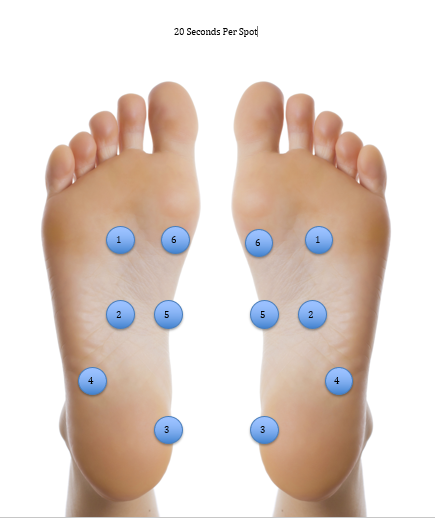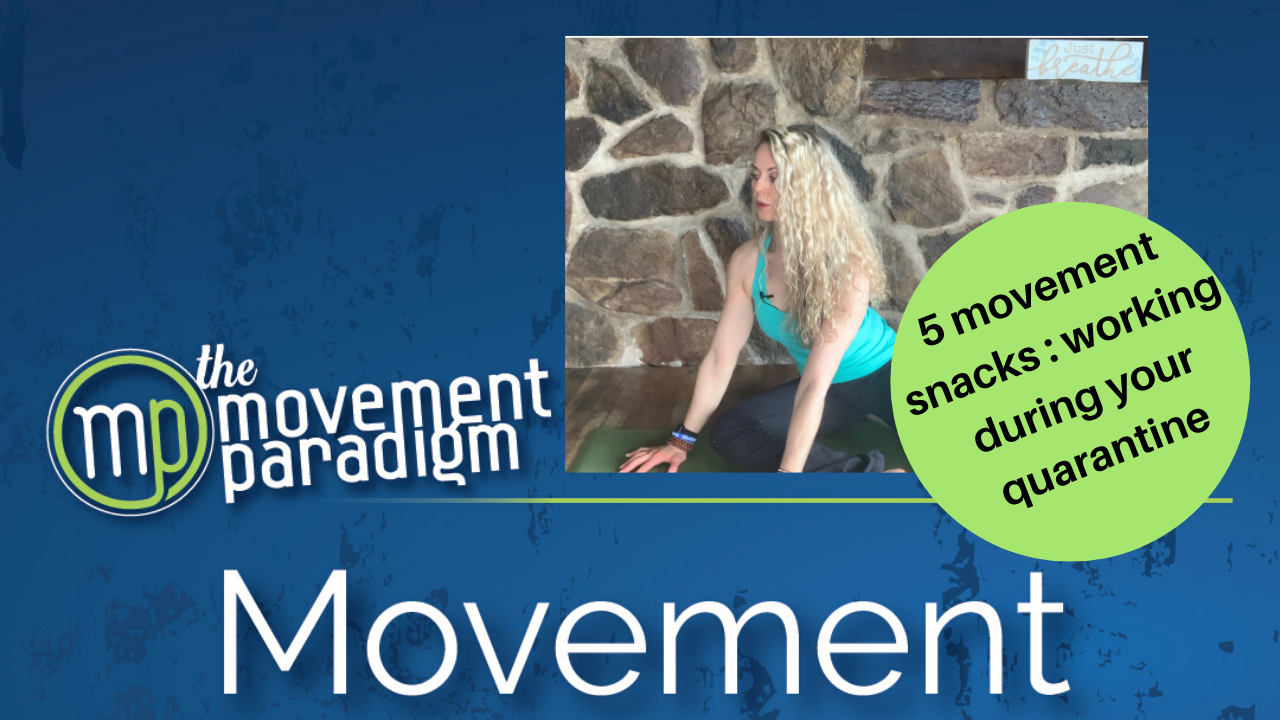I know that many of you have been working at your desk all day during this quarantine. You may not be getting up as much and probably not feeling as great as you normally do. These simple exercises can be done at your desk or the surrounding area. Rather than heading to the kitchen, here are five movement snacks that you could do throughout your day to help you get focused, energized, and maintain your mobility.
1. Cross Crawl Pattern
The cross crawl pattern will stimulate the right and left hemispheres of the brain, ultimately waking up the logical and the creative side of your brain.
To do this exercise, while sitting, place your hands behind your head, and then exhale as you bring your elbow to your opposite knee. You do not need to touch each direction but just try your best. Repeating for a series of 15 to 20 repetitions. You can also do this from standing, and the same idea, bring elbow to opposite knee. View the exercise HERE.
2. Foot Release
The foot release can be done from a seated or standing position. You can use a ball that’s the size of a golf ball. I love the RAD rounds for this. The foot release is really designed to improve the mobility of your foot and hydrate the fascia, helping to keep it elastic. You’re also stimulating certain receptors in the bottom of the feet that have a direct link to your brain. From an Eastern medicine perspective, reflexology, by applying pressure to reflex areas, is said to remove energy blockages and promote health in the related body area and research has shown to stimulate the vagus nerve as well. I recommend this to nearly every patient. It is a very powerful exercise, very simple to do, and feels amazing. It will take you just a few minutes on each side.
To do this exercise, use a small ball on the six different points on the bottom of your foot that will be included in the picture below. You’ll hold the ball in each spot for about 20 seconds, making sure that you feel a nice release (about 75% decrease in pain/discomfort), and then moving on to the next spot. View how to do the exercise HERE.

3. Half Salamander
The half salamander exercise is a cranial nerve reprogramming exercise. The goal of it is to improve the thoracic mobility, ribcage, and sternum motion, and improve the blood flow around the vertebral arteries, and ultimately the upper cervical spine. It is very simple to do and you could do it multiple times throughout the day to have a cumulative effect on the neck, shoulder, and thoracic mobility.
To do this exercise, first, check your cervical range of motion. You can do this by looking to the right and left to see if there’s any asymmetry or restriction. Then, place your hands behind your head and you’re going to side bend to one side and then look with your eyes in the opposite direction. Make sure to keep your face forward, and you’ll hold this for 30 to 60 seconds. You would of course repeat on the other side, and then you would recheck your cervical range of motion, which should be improved. To see how to do the exercise, click HERE.
4. Thoracic Rotation and Side Bend
The thoracic rotation and side bending exercise is also a great exercise to do to help negate some of the sitting postures of that forward, often rounded position. You’re using your eyes to really help improve the range of motion in the upper back. Your eyes have a direct connection to the muscles in the back of your head, the occiput muscles. So, you’re using your eyes to really drive by looking as far as you can. Each time you should be able to get successive improvements.
To do this exercise, first, check your thoracic range of motion by rotating to each side see if there are any restrictions or asymmetry. Then, place your hands behind your head and you’re going to look with your eyes all the way to the right. Next, rotate as far as you can to the right keeping your hands behind your head. When you get to your end range, side bend. Come back to the center and return to your start position. The next time, you’ll rotate even further, looking with your eyes as far as you can to the right. Then, once again side bend. Each time you should be able to get farther and farther. Repeat three times on each side, and then recheck your thoracic range of motion, which should be improved. To see the exercise, click HERE.
5. Hip Mobility 90/90
Hip mobility is very important, so you want to make sure that you take the opportunity to get down on the floor and maintain your hip motion, especially if you are going to be sitting all day at your desk. You do want to make sure that this is active-controlled mobility, so you want to make sure that you’re breathing diagrammatically in each position to convince your nervous system that you are safe in that position. Go to the point where you feel some discomfort, but it should never be painful.
To do this exercise, you will start with a 90/90 hip position. From this position, slowly rotate to the other side maintaining an upright trunk position. Using your breath, exhaling, as you rotate, and then taking your big inhale to prep the motion. Make sure you are doing this in a comfortable position and that there is no pain. Then, move into a reaching forward position on the front leg. Use tension by pushing into the ground, pushing the ground away, and hinging from the hip. It may be farther for some than others. Next, you’ll open your back up and rotate to the front leg. You’re really trying to open your chest and extend your hip on that side. Make sure to really squeeze your glute to maintain that position while breathing. To see how to perform, click HERE.
Summary
I hope that was helpful and that you gained some new movement snacks that you can do throughout your workday, especially during this quarantine. If this was helpful for you, please make sure to share it with your friends and family. The rule of thumb is to move EVERY 30 minutes while working, so try one of these or take a quick stroll. Better yet, do both!
Reach out for a 15-minute FREE discovery session to see how we can help you on your journey.
For more content, make sure to subscribe to our YouTube channel here.
Other things that may interest you:
WHY DO YOU HAVE CRAVINGS | 4 reasons

